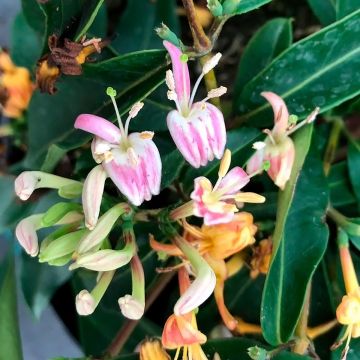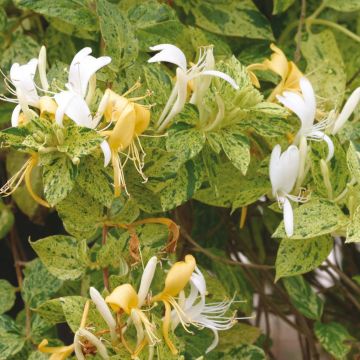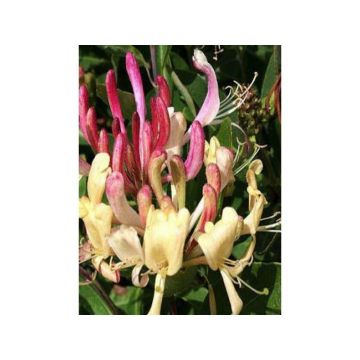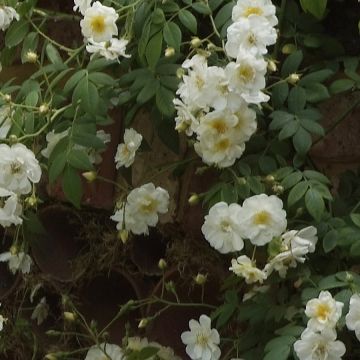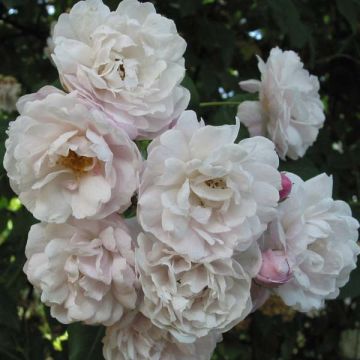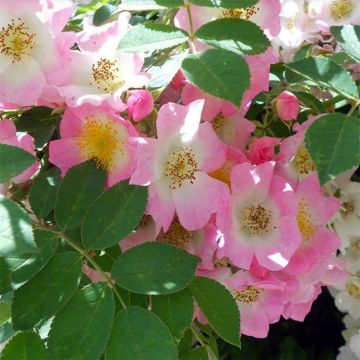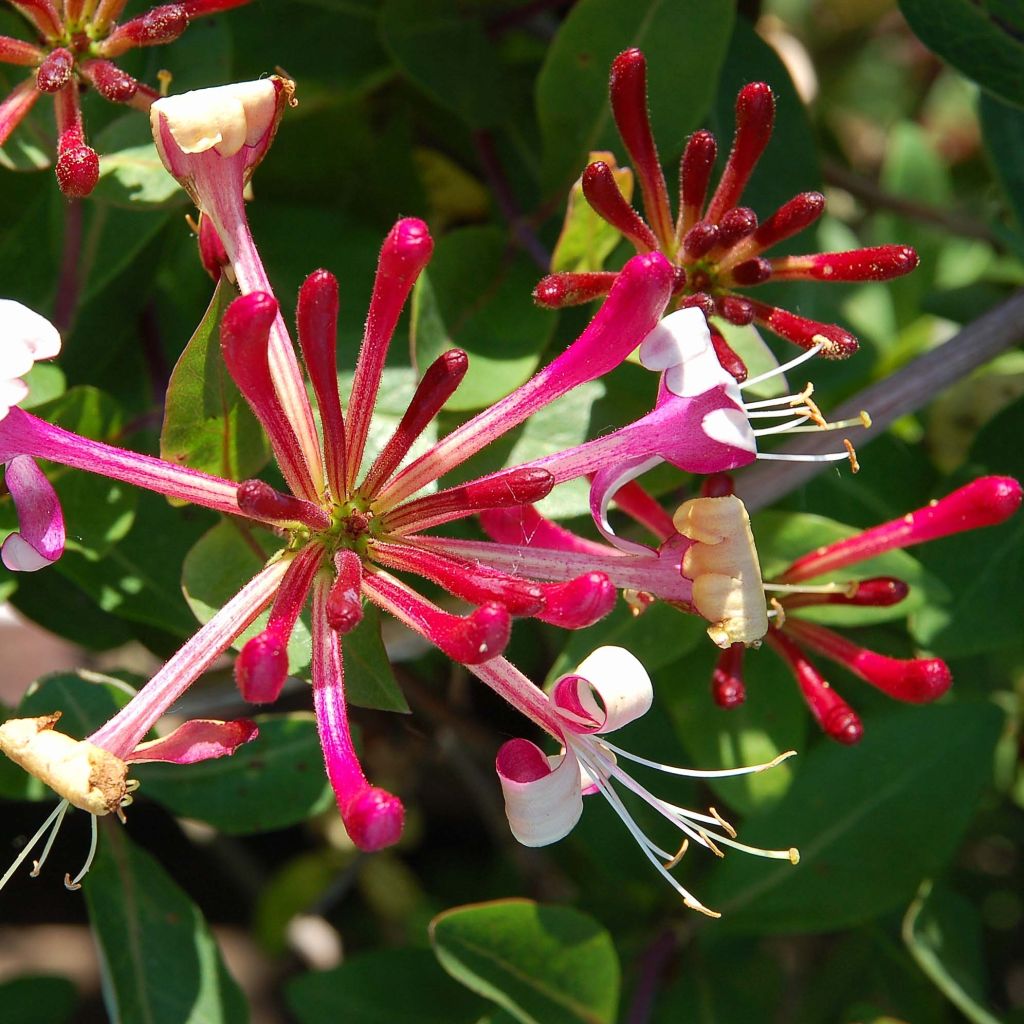

Lonicera japonica Red World - Japanese Honeysuckle
Lonicera japonica Red World - Japanese Honeysuckle
Lonicera japonica Red World
Japanese Honeysuckle, Chinese Honeysuckle
This item cannot be shipped to the selected country
Delivery charge from €5.90
Delivery to Corse prohibited
More information
Schedule delivery date,
and select date in basket
This plant carries a 6 months recovery warranty
More information
We guarantee the quality of our plants for a full growing cycle, and will replace at our expense any plant that fails to recover under normal climatic and planting conditions.
From €5.90 for pickup delivery and €6.90 for home delivery
Express home delivery from €8.90.
Delivery to Corse prohibited: UE law prohibits the import of this plant from mainland France to Corse as part of the fight against Xylella fastidiosa. Please accept our sincere apologies.
More information

Does this plant fit my garden?
Set up your Plantfit profile →
Description
The Lonicera japonica Red World is a variety of Japanese honeysuckle, a vigorous plant with a highly scented flowering. It is equally decorative when climbing on a tree or structure as when it crawls on the ground. During summer, it is adorned with small bouquets of white-pink flowers with a pleasant evening fragrance. These flowers bring life to a dense dark green foliage that will persist more or less depending on the severity of the winter. Like clematis, this climbing plant that wraps around its neighbors requires little maintenance: it thrives with its head in non-burning sun and its feet in shade, in rather moist and ordinary soil.
The Japanese honeysuckle, scientifically known as Lonicera japonica, is a climbing and woody plant, more or less evergreen, belonging to the caprifoliaceae family. This plant is easy to grow in all regions and originates from East Asia. In the wild, it shows vigorous growth and is best suited for slightly wild and spacious areas.
The 'Red World' variety stands out for the colour of its flowers. With rapid growth, this honeysuckle will reach a height of about 6m (20ft) with a spread of 3m (10ft). Its long stems wrap around any support they encounter, but they can also crawl and form ground cover. They bear simple, ovate, and pointed leaves, thick and strongly veined, arranged in an opposite manner. The leaves are a fairly dark green colour with a slight shine. If the winter is not too cold, they will remain attached to the stems. From June to August, a multitude of tubular flowers, measuring 4cm (2in), appear in clusters at the axils of the leaves. Divided into two lips, they display prominent stamens and a bicolour hue, with the exterior being pink-red and the interior turning creamy white. This flowering, with its sweet and penetrating fragrance, attracts numerous pollinating insects, particularly bees and bumblebees, followed in the evening by night-flying moths like the Sphinx. After pollination, the flowers produce small fleshy berries with a shiny black-violet color, which are not edible but highly sought after by birds.
This generous Red World honeysuckle can be planted in the ground, away from harsh sunlight, with the base in shade: it will thrive, for example, near the base of an old tree, between its large roots, provided there is a good amount of planting soil. Naturally, it is perfect for covering anything that needs to be hidden: fences, wire mesh, or sheds, as long as there is a support available. It is less known for its ability to wrap around very narrow supports, transforming even the smallest pole into a vegetated column. It can also be allowed to colonize the ground in a slightly wild area of the garden. It forms a beautiful combination with clematis. It also fits well in a hedge, alongside flowering shrubs such as lilacs, mock oranges, deutzias, or even arbustive ceanothus. If you enjoy its fragrance, plant it near the terrace or a window. The evergreen foliage in a moderate to mild climate allows you to camouflage a wall or fence even in winter.
Report an error about the product description
Lonicera japonica Red World - Japanese Honeysuckle in pictures


Plant habit
Flowering
Foliage
Botanical data
Lonicera
japonica
Red World
Caprifoliaceae
Japanese Honeysuckle, Chinese Honeysuckle
Cultivar or hybrid
Other Honeysuckle
Planting and care
The Red World honeysuckle thrives in any good deep garden soil, preferably rich and moist. If the substrate tends to dry out, consider watering in the early summers or placing the base in the shade. Mulch if necessary.
Prefer a sunny exposure to promote flowering, but not scorching. A semi-shaded position (sun in the morning, or under the cover of a light-leafed tree) will also suit it, especially if the sun is intense in your region.
Practice annual pruning to maintain an orderly shape. Carry out this task in early winter to not compromise the flowering that occurs on the wood of the year. However, it is possible to severely cut back an older subject to completely renew its framework when it forms a thick knot composed partly of dead wood. This restoration can be done over one or two years.
Honeysuckles are hardy climbing plants ideal for quickly dressing a wall or pergola. Provide them with support and they will cling on by themselves. We love them for their long flowering period and wonderful fragrance. Our advice: Plant them near your terrace to fully enjoy their intoxicating scent, which intensifies in the morning and evening.
Planting period
Intended location
Care
-
, onOrder confirmed
Reply from on Promesse de fleurs
Foolproof climbers
Haven't found what you were looking for?
Hardiness is the lowest winter temperature a plant can endure without suffering serious damage or even dying. However, hardiness is affected by location (a sheltered area, such as a patio), protection (winter cover) and soil type (hardiness is improved by well-drained soil).

Photo Sharing Terms & Conditions
In order to encourage gardeners to interact and share their experiences, Promesse de fleurs offers various media enabling content to be uploaded onto its Site - in particular via the ‘Photo sharing’ module.
The User agrees to refrain from:
- Posting any content that is illegal, prejudicial, insulting, racist, inciteful to hatred, revisionist, contrary to public decency, that infringes on privacy or on the privacy rights of third parties, in particular the publicity rights of persons and goods, intellectual property rights, or the right to privacy.
- Submitting content on behalf of a third party;
- Impersonate the identity of a third party and/or publish any personal information about a third party;
In general, the User undertakes to refrain from any unethical behaviour.
All Content (in particular text, comments, files, images, photos, videos, creative works, etc.), which may be subject to property or intellectual property rights, image or other private rights, shall remain the property of the User, subject to the limited rights granted by the terms of the licence granted by Promesse de fleurs as stated below. Users are at liberty to publish or not to publish such Content on the Site, notably via the ‘Photo Sharing’ facility, and accept that this Content shall be made public and freely accessible, notably on the Internet.
Users further acknowledge, undertake to have ,and guarantee that they hold all necessary rights and permissions to publish such material on the Site, in particular with regard to the legislation in force pertaining to any privacy, property, intellectual property, image, or contractual rights, or rights of any other nature. By publishing such Content on the Site, Users acknowledge accepting full liability as publishers of the Content within the meaning of the law, and grant Promesse de fleurs, free of charge, an inclusive, worldwide licence for the said Content for the entire duration of its publication, including all reproduction, representation, up/downloading, displaying, performing, transmission, and storage rights.
Users also grant permission for their name to be linked to the Content and accept that this link may not always be made available.
By engaging in posting material, Users consent to their Content becoming automatically accessible on the Internet, in particular on other sites and/or blogs and/or web pages of the Promesse de fleurs site, including in particular social pages and the Promesse de fleurs catalogue.
Users may secure the removal of entrusted content free of charge by issuing a simple request via our contact form.
The flowering period indicated on our website applies to countries and regions located in USDA zone 8 (France, the United Kingdom, Ireland, the Netherlands, etc.)
It will vary according to where you live:
- In zones 9 to 10 (Italy, Spain, Greece, etc.), flowering will occur about 2 to 4 weeks earlier.
- In zones 6 to 7 (Germany, Poland, Slovenia, and lower mountainous regions), flowering will be delayed by 2 to 3 weeks.
- In zone 5 (Central Europe, Scandinavia), blooming will be delayed by 3 to 5 weeks.
In temperate climates, pruning of spring-flowering shrubs (forsythia, spireas, etc.) should be done just after flowering.
Pruning of summer-flowering shrubs (Indian Lilac, Perovskia, etc.) can be done in winter or spring.
In cold regions as well as with frost-sensitive plants, avoid pruning too early when severe frosts may still occur.
The planting period indicated on our website applies to countries and regions located in USDA zone 8 (France, United Kingdom, Ireland, Netherlands).
It will vary according to where you live:
- In Mediterranean zones (Marseille, Madrid, Milan, etc.), autumn and winter are the best planting periods.
- In continental zones (Strasbourg, Munich, Vienna, etc.), delay planting by 2 to 3 weeks in spring and bring it forward by 2 to 4 weeks in autumn.
- In mountainous regions (the Alps, Pyrenees, Carpathians, etc.), it is best to plant in late spring (May-June) or late summer (August-September).
The harvesting period indicated on our website applies to countries and regions in USDA zone 8 (France, England, Ireland, the Netherlands).
In colder areas (Scandinavia, Poland, Austria...) fruit and vegetable harvests are likely to be delayed by 3-4 weeks.
In warmer areas (Italy, Spain, Greece, etc.), harvesting will probably take place earlier, depending on weather conditions.
The sowing periods indicated on our website apply to countries and regions within USDA Zone 8 (France, UK, Ireland, Netherlands).
In colder areas (Scandinavia, Poland, Austria...), delay any outdoor sowing by 3-4 weeks, or sow under glass.
In warmer climes (Italy, Spain, Greece, etc.), bring outdoor sowing forward by a few weeks.



































